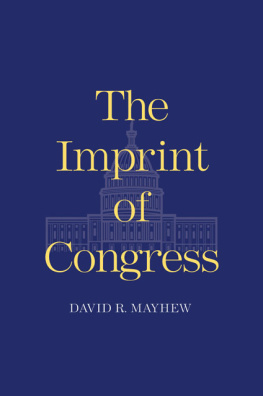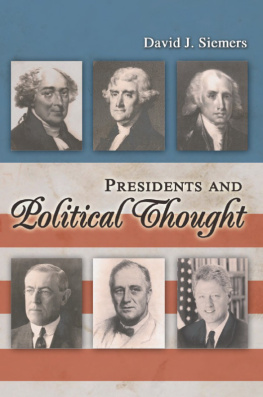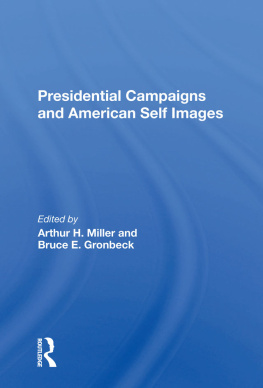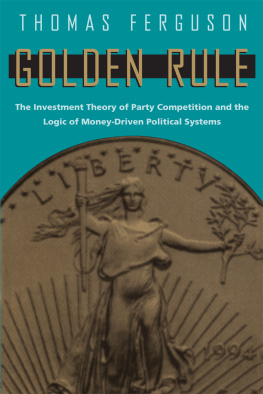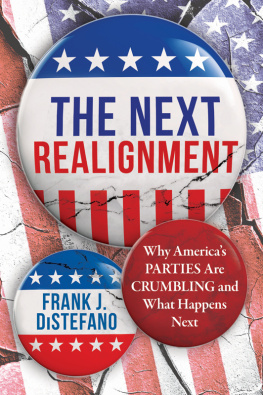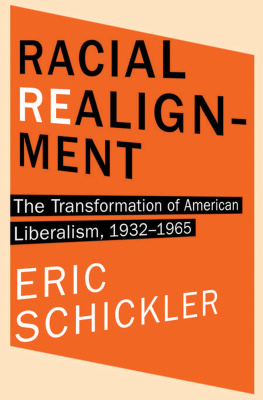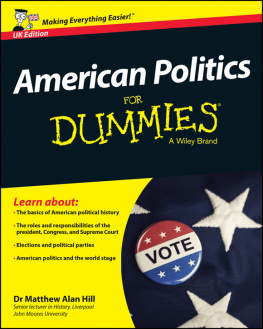Electoral Realignments
The Institution for Social and Policy Studies at Yale University
THE YALE ISPS SERIES
Electoral Realignments
A CRITIQUE OF AN AMERICAN GENRE
David R. Mayhew

Copyright 2002 by Yale University.
All rights reserved.
This book may not be reproduced, in whole or in part, including illustrations, in any form (beyond that copying permitted by Sections 107 and 108 of the U.S. Copyright Law and except by reviewers for the public press), without written permission from the publishers.
Designed by James J. Johnson and set in Aster Roman type by
Keystone Typesetting, Inc.
Printed in the United States of America by Vail-Ballou Press,
Binghamton, New York.
Library of Congress Cataloging-in-Publication Data
Mayhew, David R.
Electoral realignments : a critique of an American genre / David R. Mayhew.
p. cm. (The Yale ISPS series)
Includes bibliographical references and index.
ISBN 0-300-09336-5
1. Political partiesUnited StatesHistory. 2. ElectionsUnited StatesHistory. 3. Party affiliationUnited StatesHistory. I. Title. II. Series.
JK2261 .M364 2002
324'.0973dc21 2002016746
A catalogue record for this book is available from the British Library.
The paper in this book meets the guidelines for permanence and durability of the Committee on Production Guidelines for Book Longevity of the Council on Library Resources.
10 9 8 7 6 5 4 3 2 1
Contents
Acknowledgments
Many people helped me with this project. For their critical readings of the manuscript at various stages, I am grateful to Bruce Ackerman, Paul Allen Beck, Nigel Bowles, Robert Dahl, Alan Gerber, Donald Green, Jacob Hacker, Rogan Kersh, Joseph LaPalombara, Harvey Schantz, Eric Schickler, and Rogers Smith. For their comments following a presentation of the project at Yale University, I thank David Cameron and Stephen Skowronek. For comments provoked by a presentation of the project at a conference on American political development at the Massachusetts Institute of Technology, I am indebted to Richard Bensel, Walter Dean Burnham, Charles Cameron, John Gerring, David Hart, Christopher Howard, William Keech, Dan Kryder, and Martin Shefter. Important encouragement came from John Covell, Charles Lindblom, Byron Shafer, and Ian Shapiro. Useful tips on sources came from Ron Johnston, John Lapinski, Michael Layton, and Eric Patashnik. A major injection of accuracy came from Matthew Green, who checked the references. For books and articles, I drew on the libraries at Boston College, Boston University, Oxford University, and Yale University.
Introduction
THE STUDY OF AMERICAN ELECTORAL realignments, which enjoyed its heyday in the 1960s and 1970s, has been one of the most creative, engaging, and influential intellectual enterprises ever undertaken by American political scientists. During the 1960s and 1970s, it rivaled the Michigan election studies. Then and since, it has offered certifiable science, in the sense of a conceptual scheme, a theory, and quantitative analysis; breadth, in its tackling of large questions concerning the what, when, and why of American history; and even a secular eschatology, in the sense that it has encouraged generations of students and others, primed to seek signs along a presumed highway to an extraordinary historical destination, to keep asking: Is an electoral realignment about to happen? Are
Basic to the appeal and influence of the realignments enterprise have been the talents of four major political scientists during its creative early days: the late V. O. Key, Jr., and E. E. Schattschneider, both of whom contributed important groundwork; and James L. Sundquist and Walter Dean Burnham, who provided the principal statements in the genre. All four of these writers exhibited a prodigious, sure-footed command of the factual particulars of American political history as well as the rare ability to generalize through detecting patterns. All four offered a kind of ideological excitement, as many academics of my generation will attest. It is small wonder that the genre made such a mark during its classical phase.
Inventive additions were made to the realignments interpretation in the 1970s and 1980s by, among others, the political scientists Paul Allen Beck, David W. Brady, and, writing as a threesome, Jerome M. Clubb, William H. Flanigan, and Nancy H. Zingale.
. David M. Kennedy, Bill Clinton in the Eye of History, New York Times, Nov. 2, 2000, A31. Walter Dean Burnham, Whole Lotta Shakin Goin On: A Political Realignment Is on the Way, The Nation, Apr. 17, 2000, 1115. A few months after the 2000 election, it was reported that George W. Bushs operative Karl Rove continues to hold out the possibility that 2000 was a realigning election. See Stuart Rothenberg, Throwing Cold Water on Roves Vision of Political Realignment, Roll Call, March 1, 2001, online. See also David Frum, Were on the Edge of Realignment, American Enterprise 12:2 (March 2001), 2930.
In the canon proper, there was little creativity in the 1990s.
Yet the realignments perspective lives on, at least in political science. In undergraduate courses on parties and elections, nothing has replaced it as a device for organizing American political history.
. See, e.g., Allan J. Lichtman, The End of Realignment Theory? Toward a New Research Program for American Political History, Historical Methods 15 (1982), 17088; Richard L. McCormick, The Realignment Synthesis in American History, Journal of Interdisciplinary History 13 (1982), 85105; Richard L. McCormick, Walter Dean Burnham and The System of 1896, Social Science History 10 (1986), 24562; Peter H. Argersinger and John W. Jeffries, American Electoral History: Party Systems and Voting Behavior, Research in Micropolitics 1 (1986), 133; Edward G. Carmines and James A. Stimson, Issue Evolution: Race and the Transformation of American Politics (Princeton: Princeton University Press, 1989), 1926; Everett Carll Ladd, Like Waiting for Godot: The Uselessness of Realignment for Understanding Change in Contemporary American Politics, ch. 2 in Byron E. Shafer (ed.), The End of Realignment? Interpreting American Electoral Eras (Madison: University of Wisconsin Press, 1991).
. Richard L. McCormick, The Party Period and Public Policy: An Exploratory Hypothesis, Journal of American History 66 (1979), 27998; Joel H. Silbey, Beyond Realignment and Realignment Theory: American Political Eras, 17891989, ch. 1 in Shafer, The End of Realignment.
In the minds of many political scientists, notwithstanding the qualms of historians, the two-century-long timetable associated with the realignments canon has come to have an unquestioned fixedness approaching that of, I would imagine, the periodic table for chemists. Also, Whole Lotta Shakintype statements in the popular media have become a trademark of election seasons.
It is the continuing prominence of the realignments genre that stirred me to write this work, which takes the form of an empirical critique. It asks the question: How good is the realignments genre as a guide to the last two centuries of American electoral, party, and policy history?
. See, e.g., John B. Gates, The American Supreme Court and Electoral Realignment, Social Science History 8 (1984), 26790; David W. Brady, A Reevaluation of Realignments in American Politics: Evidence from the House of Representatives, American Political Science Review
Next page


